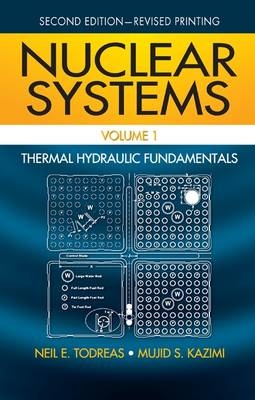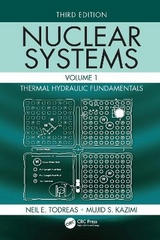
Nuclear Systems Volume I
Taylor & Francis Inc (Verlag)
978-1-4398-0887-0 (ISBN)
- Titel erscheint in neuer
- Artikel merken
Written by leading experts from MIT, Nuclear Systems Volume I: Thermal Hydraulic Fundamentals, Second Edition provides an in-depth introduction to nuclear power, with a focus on thermal hydraulic design and analysis of the nuclear core. A close examination of new developments in nuclear systems, this book will help readers—particularly students—to develop the knowledge and design skills required to improve the next generation of nuclear reactors.
Tables for Computation available for download at www.crcpress.com/product/ISBN/9781439808870
Intended for experts and senior undergraduate/early-stage graduate students, the material addresses:
Different types of reactors
Core and plant performance measures
Fission energy generation and deposition
Conservation equations
Thermodynamics
Fluid flow
Heat transfer
Imparting a wealth of knowledge, including their longtime experience with the safety aspects of nuclear installations, authors Todreas and Kazimi stress the integration of fluid flow and heat transfer, various reactor types, and energy source distribution. They cover recent nuclear reactor concepts and systems, including Generation III+ and IV reactors, as well as new power cycles. The book features new chapter problems and examples using concept parameters, and a solutions manual is available with qualifying course adoption.
Dr. Neil Todreas is professor emeritus at MIT. He has extensive nuclear power experience, having led an industry review group on the Three Mile Island situation from 1983-1988 and served on the NRC's Reactor Safety Research Committee. In addition to his part-time teaching and research, Dr. Todreas continues to be a leading consultant to industry and government. He is a Fellow at the ASME and a member of the national academy of engineering. Dr. Mujid Kazimi is a professor and former head of the Department of Nuclear Engineering at MIT. He also has extensive nuclear power experience, having served on the Board of Managers of the Idaho National Energy Laboratory. He is also a Fellow at the American Nuclear Society and the AAAS, and a member of the AIChE, ASME and ASEE. Dr. Kazimi has been involved with several nuclear safety studies throughout his career, covering reactor systems, as well as their fuel cycles.
Principal Characteristics of Power Reactors
Introduction
Power Cycles
Primary Coolant Systems
Reactor Cores
Fuel Assemblies
Advanced Water- and Gas-Cooled Reactors (Generation III And III+)
Advanced Thermal and Fast Neutron Spectrum Reactors (Generation IV)
References
Problems
Thermal Design Principles and Application
Introduction
Overall Plant Characteristics Influenced by Thermal Hydraulic Considerations
Energy Production and Transfer Parameters
Thermal Design Limits
Thermal Design Margin
Figures of Merit for Core Thermal Performance
The Inverted Fuel Array
The Equivalent Annulus Approximation
References
Problems
Reactor Energy Distribution
Introduction
Energy Generation and Deposition
Fission Power and Calorimetric (Core Thermal) Power
Power Profiles in Reactor Cores
Energy Generation Rate within a Fuel Pin
Energy Deposition Rate within The Moderator
Shutdown Energy Generation Rate
Stored Energy Sources
References
Problems
Transport Equations for Single-Phase Flow
Introduction
Mathematical Relations
Lumped Parameter Integral Approach
Distributed Parameter Integral Approach
Differential Conservation Equations
Turbulent Flow
References
Problems
Transport Equations for Two-Phase Flow
Introduction
Averaging Operators for Two-Phase Flow
Volume-Averaged Properties
Area-Averaged Properties
Mixture Equations for One-Dimensional Flow
Control-Volume Integral Transport Equations
One-Dimensional Space-Averaged Transport Equations
References
Problems
Thermodynamics of Nuclear Energy Conversion Systems: Nonflow and Steady Flow: First and Second Law Applications
Introduction
Nonflow Process
Thermodynamic Analysis of Nuclear Power Plants
Thermodynamic Analysis of a Simplified Pwr System
More Complex Rankine Cycles: Superheat, Reheat, Regeneration, and Moisture Separation
Simple Brayton Cycle
More Complex Brayton Cycles
Reference
Problems
Thermodynamics of Nuclear Energy Conversion Systems: Nonsteady Flow First Law Analysis
Introduction
Containment Pressurization Process
Response of a PWR Pressurizer to Load Changes
References
Problems
Thermal Analysis of Fuel Elements
Introduction
Heat Conduction in Fuel Elements
Thermal Properties of UO2 and MOx
Temperature Distribution in Plate Fuel Elements
Temperature Distribution in Cylindrical Fuel Pins
Temperature Distribution in Restructured Fuel Elements
Thermal Resistance Between Fuel and Coolant
References
Problems
Single-Phase Fluid Mechanics
Approach to Simplified Flow Analysis
Inviscid Flow
Viscous Flow
Laminar Flow Inside a Channel
Turbulent Flow Inside a Channel
Pressure Drop in Rod Bundles
References
Problems
Single-Phase Heat Transfer
Fundamentals of Heat Transfer Analysis
Laminar Heat Transfer in a Pipe
Turbulent Heat Transfer: Mixing Length Approach
Turbulent Heat Transfer: Differential Approach
Heat Transfer Correlations in Turbulent Flow
References
Problems
Two-Phase Flow Dynamics
Introduction
Flow Regimes
Flow Models
Overview of Void Fraction and Pressure Loss Correlations
Void Fraction Correlations
Pressure-Drop Relations
Critical Flow
References
Problems
Pool Boiling
Introduction
Nucleation
The Pool Boiling Curve
Heat Transfer Regimes
Surface Effects in Pool Boiling
Condensation Heat Transfer
References
Problems
Flow Boiling
Introduction
Heat Transfer Regions and Void Fraction/Quality Development
Heat Transfer Coefficient Correlations
Critical Condition or Boiling Crisis
References
Problems
Single Heated Channel: Steady-State Analysis
Introduction
Formulation of One-Dimensional Flow Equations
Delineation of Behavior Modes
The Lwr Cases Analyzed in Subsequent Sections
Steady-State Single-Phase Flow in a Heated Channel
Steady-State Two-Phase Flow in a Heated Channel Under Fully Equilibrium (Thermal and Mechanical) Conditions
Steady-State Two-Phase Flow in a Heated Channel Under Nonequilbrium Conditions
References
Problems
APPENDICES
Appendix A: NOMENCLATURE
Appendix B: PHYSICAL AND MATHEMATICAL CONSTANTS
Appendix C: UNIT SYSTEMS
Appendix D: MATHEMATICAL TABLES
Appendix E: THERMODYNAMIC PROPERTIES
Appendix F: THERMOPHYSICAL PROPERTIES OF SOME SUBSTANCES
Appendix G: DIMENSIONLESS GROUPS OF FLUID MECHANICS AND HEAT TRANSFER
Appendix H: MULTIPLYING PREFIXES
Appendix I: LIST OF ELEMENTS
Appendix J: SQUARE AND HEXAGONAL ARRAY DIMENSIONS
Appendix K PARAMETERS FOR TYPICAL PWR AND BWR-5 REACTORS
| Erscheint lt. Verlag | 26.10.2011 |
|---|---|
| Zusatzinfo | 10/15- ALL EBooks corrected; 1303+ equations-SEE NOTES 6th & 1st print-10/15-whole book re-done; 134 Tables, black and white; 343 Illustrations, black and white |
| Verlagsort | Washington |
| Sprache | englisch |
| Maße | 156 x 235 mm |
| Gewicht | 1474 g |
| Themenwelt | Naturwissenschaften ► Physik / Astronomie |
| Technik ► Elektrotechnik / Energietechnik | |
| Technik ► Maschinenbau | |
| ISBN-10 | 1-4398-0887-2 / 1439808872 |
| ISBN-13 | 978-1-4398-0887-0 / 9781439808870 |
| Zustand | Neuware |
| Informationen gemäß Produktsicherheitsverordnung (GPSR) | |
| Haben Sie eine Frage zum Produkt? |
aus dem Bereich



